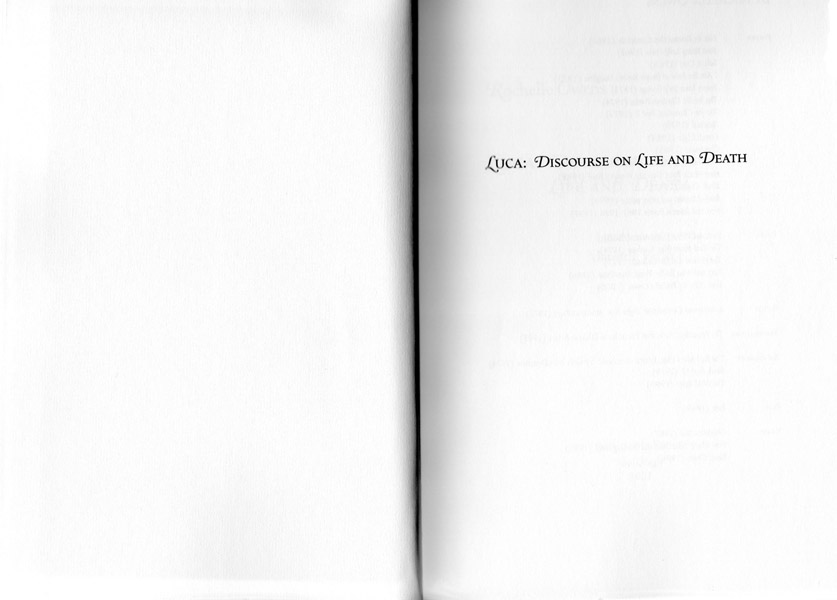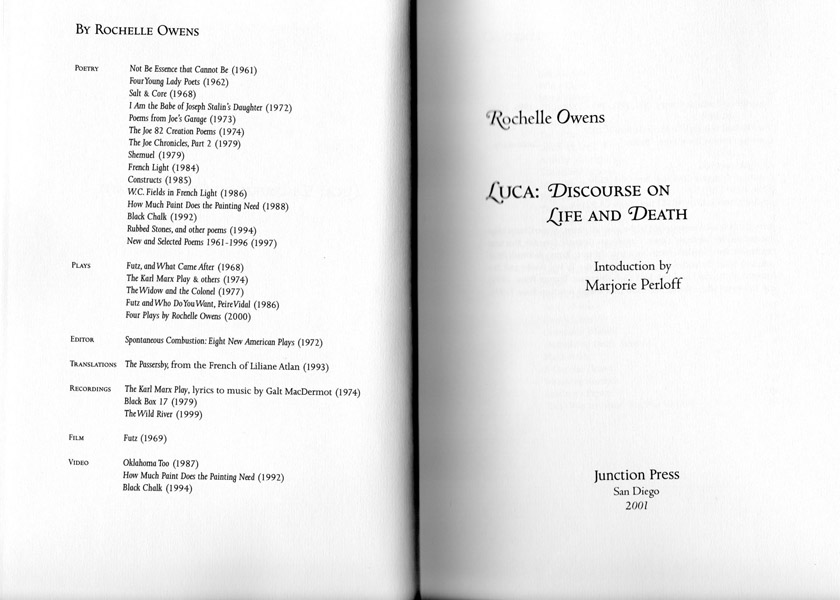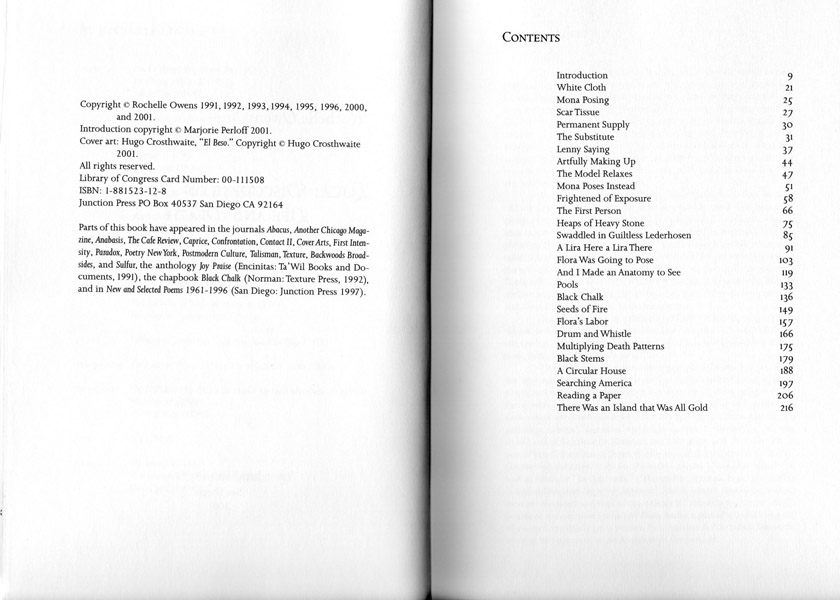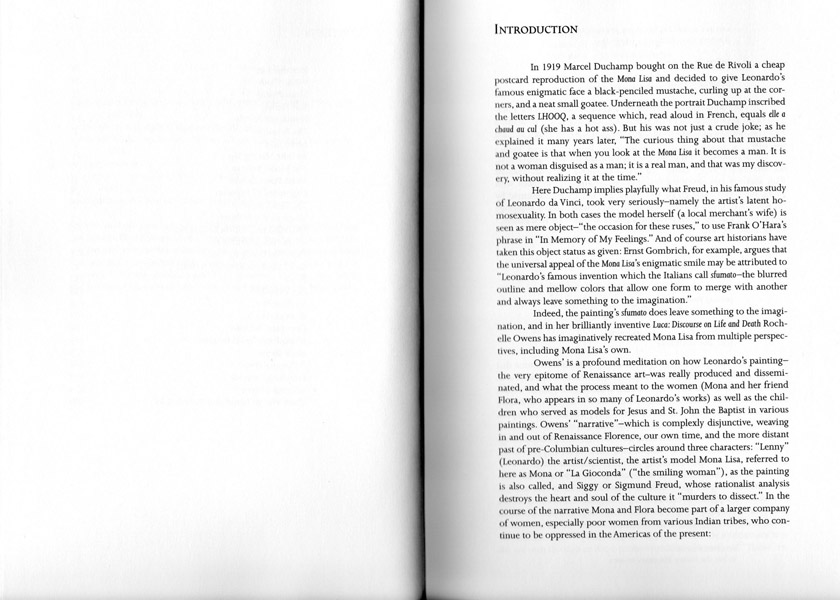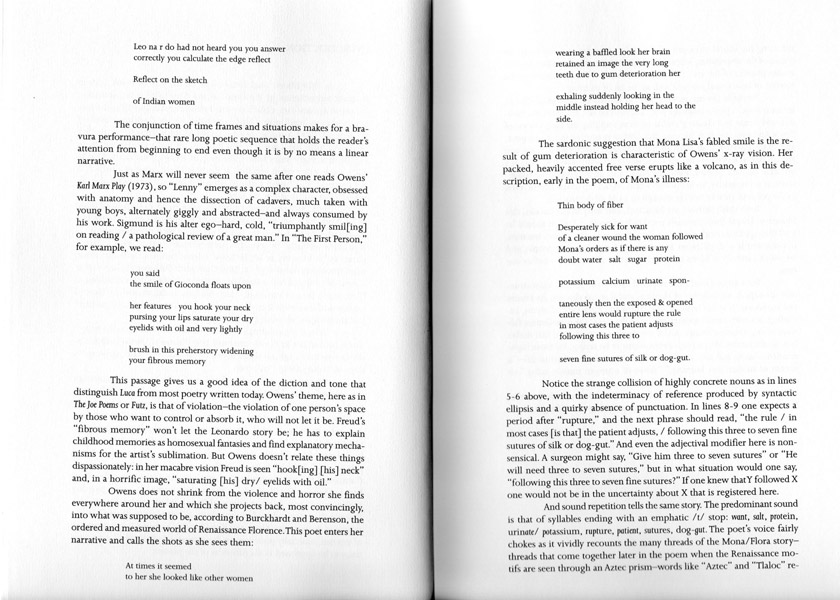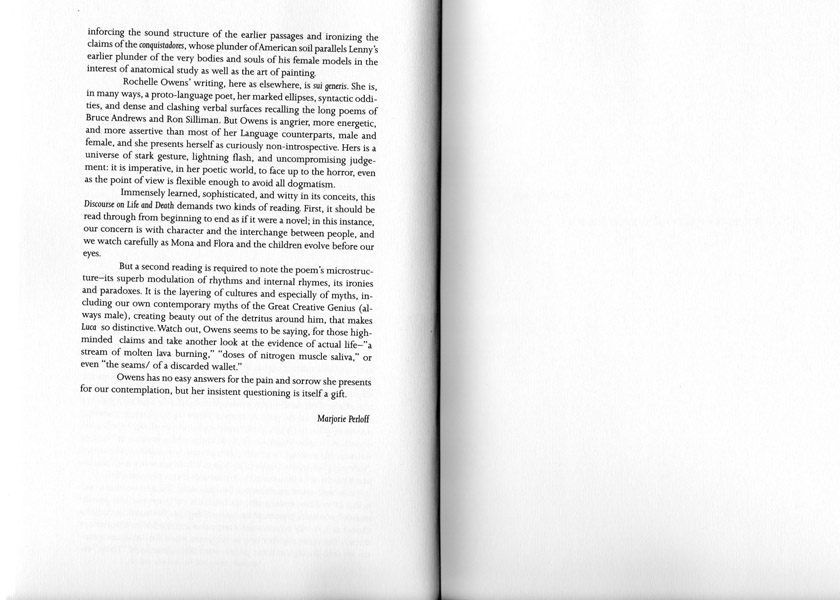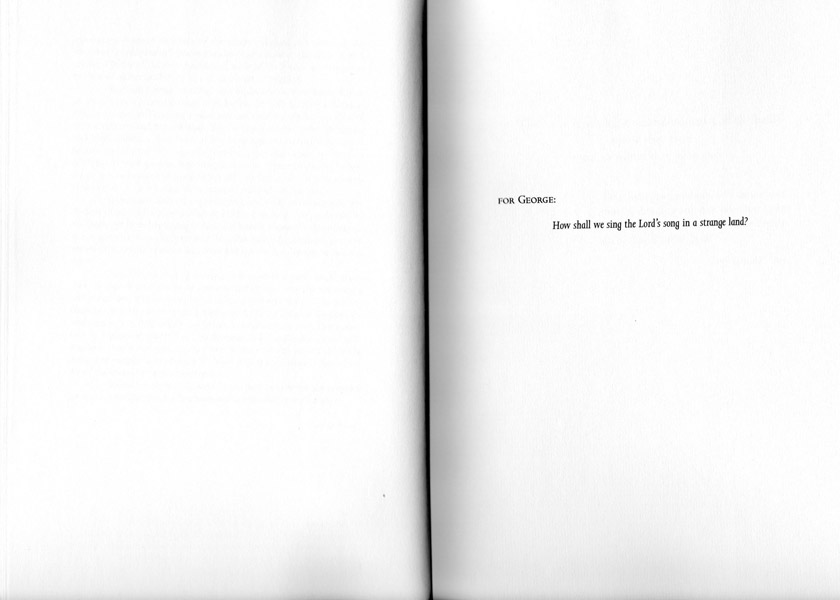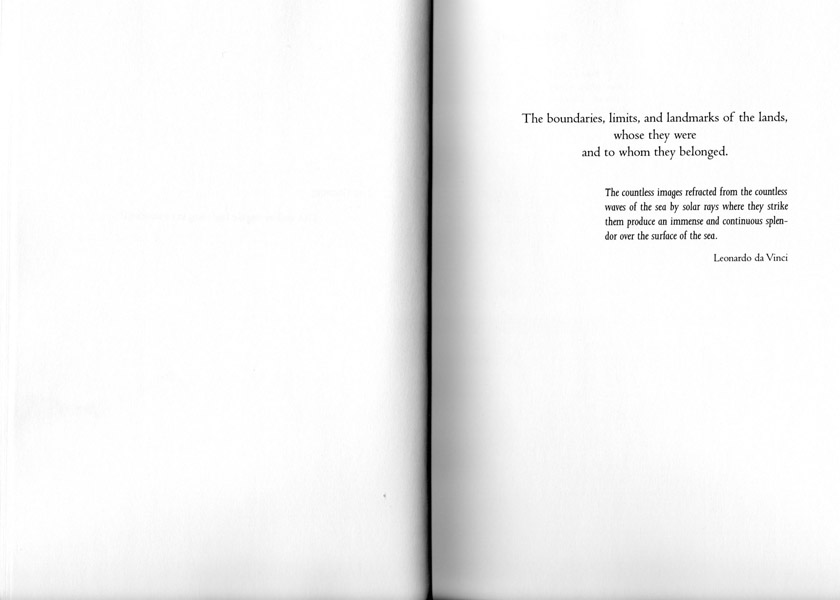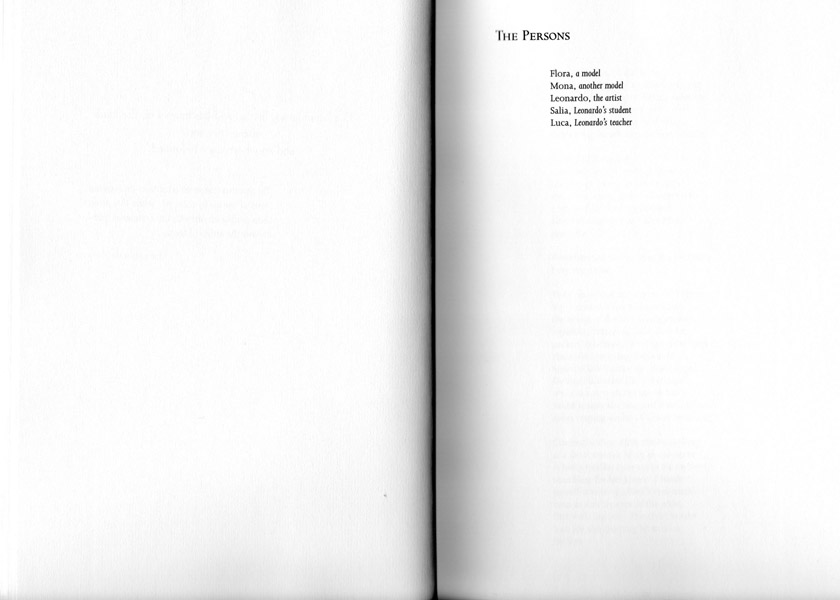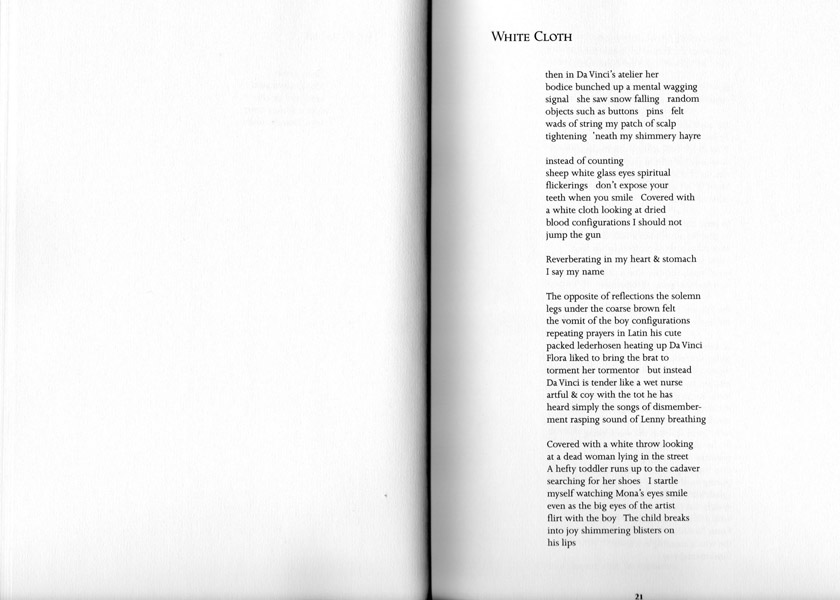Poetry Books
The Aardvark Venus: New & Selected Poems 1961-2020
Hermaphropoetics: Drifting Geometries
Out of Ur: New & Selected Poems 1961-2012
Solitary Workwoman
Luca: Discourse on Life and Death
New and Selected Poems 1961-1996
Rubbed Stones
Black Chalk
How Much Paint Does the Painting Need
W. C. Fields in French Light
Constructs
The Joe Chronicles Part 2
Shemuel
The Joe 82 Creation Poems
I Am the Babe of Joseph Stalin's Daughter
Salt and Core
Not Be Essence That Cannot Be
Luca: Discourse on Life and Death
2001, Junction Press
The process of writing the long poem "Luca, Discourse on Life and Death" was similar to creating a water color painting. In spite of the risks, little or no revision was needed in order to save the nuances, range, rhythms and depth. Thus, I avoided applying certain habitual skills which would have taken me to a familiar place and not on a new journey.
"Luca, Discourse on Life and Death" was revised with white-out correction fluid. Pages were often unnumbered so that the text could be organized in accordance with this process.
My knowledge, experience, imagination, intuition, emotion, reflection, psychic energy—was given over to the authority of language—its momentum—from which the poem evolved. The alphabet is the ocean—I swam in the alphabet.
If there was "le bruit parasite," static—flotsam and jetsam—I used the white-out to eliminate it, and shape new contextual relationships. However, if a problem happened—an obstacle that seemed to be interesting and had potential—I would work hard to integrate it, coordinating it into the pattern of the poem, thus revealing another metamorphosis—a new facet of "Luca, Discourse on Life and Death."
In 1919 Marcel Duchamp bought on the Rue de Rivoli a cheap postcard reproduction of the Mona Lisa and decided to give Leonardo's famous enigmatic face a black-penciled mustache, curling up at the corners, and a neat small goatee. Underneath the portrait Duchamp inscribed the letters LHOOQ, a sequence which, read aloud in French, equals elle a chaud au cul (she has a hot ass). But his was not just a crude joke; as he explained it many years later, "The curious thing about that mustache and goatee is that when you look at the Mona Lisa it becomes a man. It is not a woman disguised as a man, it is a real man, and that was my discovery, without realizing it at the time."
Here Duchamp implies playfully what Freud, in his famous study of Leonardo da Vinci, took very seriously—namely the artists latent homosexuality. In both cases the model herself (a local merchant's wife) is seen as mere object—"the occasion for these ruses," to use Frank O'Hara's phrase in "In Memory of My Feelings." And of course art historians have taken this object status as given: Ernst Gombrich, for example, argues that the universal appeal of the Mona Lisa's enigmatic smile may be attributed to "Leonardo's famous invention which the Italians call sfumato—the blurred outline and mellow colors that allow one form to merge with another and always leave something to the imagination."
Indeed, the painting's sfumato does leave something to the imagination, and in her brilliantly inventive Luca: Discourse on Life and Death Rochelle Owens has imaginatively recreated Mona Lisa from multiple perspectives, including Mona Lisa's own.
Owens' is a profound meditation on how Leonardo's painting—the very epitome of Renaissance art—was really produced and disseminated, and what the process meant to the women (Mona and her friend Flora, who appears in so many of Leonardo's works) as well as the children who served as models for Jesus and St. John the Baptist in various paintings. Owens' "narrative"—which is complexly disjunctive, weaving in and out of Renaissance Florence, our own time, and the more distant past of pre-Columbian cultures—circles around three characters: "Lenny" (Leonardo) the artist/scientist, the artist's model Mona Lisa, referred to here as Mona or "La Gioconda" ("the smiling woman"), as the painting is also called, and Siggy or Sigmund Freud, whose rationalist analysis destroys the heart and soul of the culture it "murders to dissect." In the course of the narrative Mona and Flora become part of a larger company of women, especially poor women from various Indian tribes, who continue to be oppressed in the Americas of the present:
Leo na r do had not heard you you answer
correctly you calculate the edge reflect
Reflect on the sketch
of Indian women
The conjunction of time frames and situations makes for a bravura performance—that rare long poetic sequence that holds the reader's attention from beginning to end even though it is by no means a linear narrative.
Just as Marx will never seem the same after one reads Owens' Karl Marx Play (1973), so "Lenny" emerges as a complex character, obsessed with anatomy and hence the dissection of cadavers, much taken with young boys, alternately giggly and abstracted—and always consumed by his work. Sigmund is his alter ego—hard, cold, "triumphantly smil[ing] on reading / a pathological review of a great man." In "The First Person," for example, we read:
you said
the smile of Gioconda floats upon
her features you hook your neck
pursing your lips saturate your dry
eyelids with oil and very lightly
brush in this preherstory widening
your fibrous memory
This passage gives us a good idea of the diction and tone that distinguish Luca from most poetry written today. Owens' theme, here as in The Joe Poems or Futz, is that of violation—the violation of one person's space by those who want to control or absorb it, who will not let it be. Freud's "fibrous memory" won't let the Leonardo story be; he has to explain childhood memories as homosexual fantasies and find explanatory mechanisms for the artist's sublimation. But Owens doesn't relate these things dispassionately: in her macabre vision Freud is seen "hook[ing] [his] neck" and, in a horrific image, "saturating [his] dry/ eyelids with oil."
Owens does not shrink from the violence and horror she finds everywhere around her and which she projects back, most convincingly into what was supposed to be, according to Burckhardt and Berenson, the ordered and measured world of Renaissance Florence. This poet enters her narrative and calls the shots as she sees them:
At limes it seemed
to her she looked like other women
wearing a baffled look her brain
retained an image the very long
teeth due to gum deterioration her
exhaling suddenly looking in the
middle instead holding her head to the
side.
The sardonic suggestion that Mona Lisa's fabled smile is the result of gum deterioration is characteristic of Owens' x-ray vision. Her packed, heavily accented free verse erupts like a volcano, as in this description, early in the poem, of Mona's illness:
Thin body of fiber
Desperately sick for want
of a cleaner wound the woman followed
Mona's orders as if there is any
doubt water salt sugar protein
potassium calcium urinate spon-
taneously then the exposed & opened
entire lens would rupture the rule
in most cases the patient adjusts
following this three to
seven fine sutures of silk or dog-gut.
Notice the strange collision of highly concrete nouns as in lines 5–6 above, with the indeterminacy of reference produced by syntactic ellipsis and a quirky absence of punctuation. In lines 8–9 one expects a period after "rupture," and the next phrase should read, "the rule / in most cases [is that] the patient adjusts, / following this three to seven fine sutures of silk or dog-gut." And even the adjectival modifier here is nonsensical. A surgeon might say, "Give him three to seven sutures" or "He will need three to seven sutures," but in what situation would one say "following this three to seven fine sutures?" If one knew that Y followed X one would not be in the uncertainty about X that is registered here.
And sound repetition tells the same story. The predominant sound is that of syllables ending with an emphatic /t/ stop: want, salt, protein, urinate/ potassium, rupture, patient, sutures, dog-gut.The poet's voice fairly chokes as it vividly recounts the many threads of the Mona/Flora story—threads that come together later in the poem when the Renaissance motifs are seen through an Aztec prism—words like "Aztec" and "Tlaloc" reinforcing the sound structure of the earlier passages and ironizing the claims of the conquistadores, whose plunder of American soil parallels Lenny's earlier plunder of the very bodies and souls of his female models in the interest of anatomical study as well as the art of painting.
Rochelle Owens' writing, here as elsewhere, is sui generis. She is, in many ways, a proto-language poet, her marked ellipses, syntactic oddities, and dense and clashing verbal surfaces recalling the long poems of Bruce Andrews and Ron Silliman. But Owens is angrier, more energetic, and more assertive than most of her Language counterparts, male and female, and she presents herself as curiously non-introspective. Hers is a universe of stark gesture, lightning flash, and uncompromising judgement: it is imperative, in her poetic world, to face up to the horror, even as the point of view is flexible enough to avoid all dogmatism.
Immensely learned, sophisticated, and witty in its conceits, this Discourse on Life and Death demands two kinds of reading. First, it should be read through from beginning to end as if it were a novel; in this instance, our concern is with character and the interchange between people, and we watch carefully as Mona and Flora and the children evolve before our eyes.
But a second reading is required to note the poem's microstructure—its superb modulation of rhythms and internal rhymes, its ironies and paradoxes. It is the layering of cultures and especially of myths, including our own contemporary myths of the Great Creative Genius (always male), creating beauty out of the detritus around him, that makes Luca so distinctive. Watch out, Owens seems to be saying, for those high-minded claims and take another look at the evidence of actual life—"a stream of molten lava burning," "doses of nitrogen muscle saliva," or even "the seams/ of a discarded wallet."
Owens has no easy answers for the pain and sorrow she presents for our contemplation, but her insistent questioning is itself a gift.
Marjorie Perloff
By the early 60s, Rochelle Owens had moved far from the Beat influence that surrounded her, and was producing work which anticipated the language poets in their more Dada-esque, Kurt Schwitters-inspired montage productions. Owens' poetics were inflected with a characteristic energy and humor, always provocative, often disturbing. Unaccompanied by a critical apparatus which might have served to explicate her work, however, Owens was largely misunderstood. Later, other poets writing avant-garde or experimental work would see the value in producing companion essays or critical articles, which would not only serve as a bridge to a fuller understanding, but also to legitimize the poetics themselves. Owens did not write such companion pieces, which resulted in a body of poetic work that was neglected by the very audience that should have appreciated lt. Due to a number of additional factors, sexism and elitism among them, this independent Jewish artist, largely self-educated and deeply committed to an alternative, avant-garde vision, was not given the serious consideration she deserved as a poet in the early 1960s.
Fortunately, Owens' plays fared better than her poetry, primarily because they were more easily placed within the context of a sort of proto-punk sensibility which pierced the fragile shell of contemporary bourgeois values while parodying "youth-generation" productions such as Hair and Oh! Calcutta! Further, it was a fairly comfortable task to place Owens' farcical larger-than-life characters within a middle-brow appreciation of contemporary feminist and Marxist issues. While her plays met with accolades and even Obie awards, it ls still unclear whether or not the critics fully understood or appreciated that her plays were actually a lampoon of previous Obie winners. Perhaps it did not matter; suffice it to say that Owens works on many levels, farce being only one of them. In this sense, Owens' plays are also not too distant cousins of MAD magazine, and even anticipate the energies of '90s cultural lampoons such as shock-jocks and South Park.
Over time, Owens' poetry moved away from proto-Language textual collages to what appears to be a shamanistic, incantatory style. But this was not the tribal shamanism of a Jerome Rothenberg. Above all, Owens is a lacerating commentator on the roles people assume, and the twisted dependencies and relationships that ensue. Nevertheless, in the '70s and '80s, her work dealt with the search for transcendence or an introspective osmosis with cultural difference. She also began to explore the vexed dynamics of obsession, and she sought a way to enact how victims are ineluctably drawn to their victimizers. What ultimately captivates Owens is a transgressive art that explores psychic dysfunction on every level. Characterized by repetitions of phrases, insertions of dramatic monologues, and abrupt diction shifts, Owens' poetics deliberately place the reader off-balance. Further, her jolting prosody creates an almost ante-lyrical space which ironizes the jazz-inflected flow of the more Whitmanesque of the Beats.
Although Owens established an uneasy place with some camps in creative writing programs in certain universities, and she has won deeply faithful admirers in Europe, particularly in France, there is no doubt that she has been largely marginalized by critics, anthologists, and even other poets. Even her admirers have had a way of deprecating her through backhanded "praise," presenting her work as though it were a rather unusual outlier whose provenance lies somewhere between Olson's Maximus poems and Baudelaires Les Fleurs du Mal. And yet, to do so is a great injustice to Owens, whose world, though literary, is not academic. Comparisons can be specious at best, but if one were to find a model, it would be in the soi-disant intellectual kaleidoscope of Jean Dubuffet.
Of course, it doesn't help matters that Owens herself gives her latest work a rather off-putting title: Luca: Discourse on Life and Death. With rhythms that are repetitive, lines that are more performative than strictly poetic, pushing language to its extremes and cajoling out of it multiplicities of interpretive possibilities, Luca is less a fleshing-out of ideas than an enactment of them. The work itself has more to do with the grinding pulses and profane mantras of pop culture's advertising, music videos, streaming videos, and action films than of the ethnographies of indigenous cultures and ideological feminist verse. As for parallels in visual art, it has more in common with body art's extreme tattoos and piercings than the fauvist and surrealist trends usually cited as antecedents or influences. This is not to say that Owens' work is not strong in intellectual or theoretical content. In Luca, the bedraggled band of ragtag time-travelers—Lenny (Leonardo Da Vinci), Mona (Mona Lisa), Siggy (Sigmund Freud), and others&mdashtraipse about a genocide-stained brave new world, which looks at times suspiciously like Oklahoma, Owens' adopted home. The individual works in the long poem-cycle do contain, as Marjorie Perloff points out in the introduction, a nexus in violation. The no longer extant Nez Perce Indians, the Aztec victims of genocide, as well as cultural figures who violated mental (Sigmund Freud's unconscious) and physical (Da Vinci's dissections and anatomical studies) space, all figure prominently in a tightly woven tapestry of repeated phrases and images. Many of the images involve hands, production, earth, and blood. Ironically, this all takes place in the "new world"—a living canvas upon which the Spanish created their greatest performance piece and earthwork. For Owens, the art materials used were of indigenous origin—earth, bone, flesh, and blood. Her emphasis is on the spectacle of authorship itself, whether one is the author of genocide or some other performative act. Here, the subject of the poem is the intent to make or produce spectacle. Authority, authorship, and authenticity are irrelevant, as is any sort of introspection. Owens does not inject or project her own thoughts and attribute them to the victims of genocide or to the artists or models themselves. Instead, the spectacle is the writing itself, and the repetitions as they unfold.
In Luca, each repetition of "counted one for crow one for cutworm" or "scattered cremains" or "placed the infected blankets one by one" heighten the sense that one is re-enacting the horrors of genocide. In doing so, Owens creates a space in which the reader can come to see genocide or ethnic cleansing as monotonous and infinitely repeated acts. Although the acts involve the conquest of North America, the discourse is firmly of the twentieth century, with Armenia, Germany, Siberia, Central Europe, Kosovo, Cambodia, Tibet, Rwanda, Guatemala as only a few of the settings. Needless to say, Owens' work is not a didactic text, although one can gain an appreciation of the inner dynamics of genocide. Owens' focus is on spectacle-making and creation.
On certain levels, Luca can be read as directly responding to the Yasusada literary hoax by taking it even further. Instead of appropriating the pain and suffering of a people and distilling it into one simple urtext, or a single "voice" to metonymize the entire event, Owens places European "high art" in the soon-to-be-conquered "new world" and states that genocide and individual suffering have no meaning except in the spectacle itself and how the artist can make it apply to individual consciousness, however ephemeral the notion of individual consciousness may be. The ethics are absolutely problematic. But will anyone care? Most likely, Owens will be largely ignored because she is not a part of the academy; or if she is acknowledged at all, it will be in a patronizing way, implying that she was not fully conscious of what she was actually saying, but was more or less enacting the role of Yeats's wife who channeled the text of A Vision.
Luca represents a viciously ironic destruction of individuality, and, moreover, of the holdovers of Romanticism which manifest themselves in contemporary lyric poetry, and even in Language poetics, despite authors' claims that their texts are devoid of the conceit of a self or essence. I would be misleading readers if I were to claim that reading Luca is a comfortable endeavor. In "Artfully Making Up," Owens ironizes how the spectacle of creation is, ultimately, about the destruction of essence: "My face is smeared and powdered / artfully made up." Luca should be made into a pattern for extreme piercings, an indication that Foucault's "limit experiences," once enacted, have nowhere to go but into either the relivings of memory or the retellings of performance.
LUCA IS A COLLECTION of twenty-seven interrelated poems written over a ten-year period, covering themes ranging from art production in Renaissance Italy to North American genocide. With its vast scope, investigating what it means to represent human life and how art can be defined not only by the audience but by the materials of the art itself, the entire work takes on the feel of an epic cycle or a saga.
Vaguely reminiscent of contemporary art productions chronicling the Holocaust or even a notorious literary hoax ostensibly produced by a Hiroshima survivor, Luca goes a step further than previous work, juxtaposing Leonardo Da Vinci's atelier with Moctezuma's Mexico. Both the atelier and Mexico are poised on the edge of a great production: one being Da Vinci's representation of Mona Lisa on a canvas, the other being the Spanish conquistadors' representation of European "civilization" on the earth canvas of the "New World." The first half of Rochelle Owens' collection is set in Da Vinci's atelier, where the models discuss the relationship of the model to the artist and art production.
While the artist builds the representation of the body, the theme of art itself is problematized by the numerous references to body parts, particularly reproductive organs. Instead of a quest for unity, the emphasis is on fragmentation and dissection. Further, with the repeated phrases "your long gray hands" and "black skin turns white" and "nailed your darkened uterus," the images created are of death, even as the artist ostensibly creates life. Beginning with "White Cloth," which can signify both a canvas and a shroud, and ending with "There Was an Island That Was All Gold," Owens carries the subject of the art itself, the model (in this case Mona Lisa), from a beginning to an end. The beginning is the promise of what the artistic production will bring. The end is a reprise of the original dream -- a utopia, a Shangri-La, or the seven cities of Cibola -- but with the realization that art itself can neither fully represent nor create a utopian reality.
In Luca the Aztec victims of genocide, as well as cultural figures who violated mental and physical space, figure prominently in a tightly woven tapestry of repeated phrases and images. The emphasis is on the spectacle of authorship itself, whether one is the author of genocide or of a piece commissioned by a patron. This is not to say that Luca suggests that the conquistadors' atrocities and violations were a Fluxus-type performance, intended simply to be performance art. Instead, the focus here is the intent to make or produce spectacle. Further, as Marjorie Perloff points out in her introduction, Owens' theme in Luca is violation. Violation, in its multiple manifestations, allows the spectacle to take on many forms. In this sense, authority, authorship, and authenticity are irrelevant, as is any sort of introspection. Owens does not inject or project her own thoughts and attribute them to the victims of genocide or to the artists or models themselves. Instead, the spectacle is the writing itself, in canvas as it unfolds and folds itself back up, this time as a shroud.
Susan Smith Nash
University of Oklahoma
